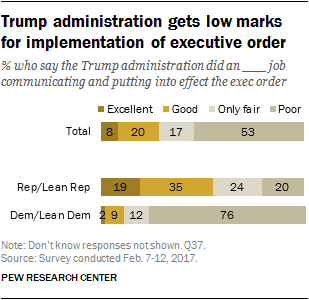Most Americans disapprove of the policy outlined in Trump’s executive order to stop refugees from entering the U.S. for 120 days and to prevent people from seven majority-Muslim countries from entering the U.S. on a visa for 90 days: 59% say they disapprove, compared with fewer (38%) who say they approve of this policy.

Nearly all Americans (95%) have heard at least a little about Trump’s executive order, including 78% who say they have heard “a lot” about it – a notably high level of public awareness.
There are wide demographic differences in views about the policy outlined in Trump’s highly-visible executive order.
Whites are divided over the policy: 49% approve, while about as many (50%) disapprove. By comparison, wide majorities of blacks (84%) and Hispanics (79%) say they disapprove of the policy.
Majorities of those ages 18-29 (76%) and 30-49 (62%) disapprove of the policy to restrict entry into the U.S. Older adults hold mixed views: 47% of those ages 50 and older approve, while 49% disapprove.
Among white evangelical Protestants, there is widespread support for the policy outlined in the executive order. Roughly three-quarters (76%) of white evangelicals approve, compared with just 22% who disapprove. White mainline Protestants express less support: 50% approve, while about as many (47%) disapprove. Most Catholics (62%) and those unaffiliated with a religion (74%) say they disapprove of the policy.
Across levels of educational attainment, more say they disapprove than approve of the policy in Trump’s executive order, though disapproval is greater among those with more education. For example, 69% of postgraduates disapprove of the policy, compared with 54% of those with no college experience.
In reflecting on the execution of the order separate from the policy itself, most rate the Trump administration negatively. About half of Americans (53%) say the Trump administration did a poor job communicating the executive order and putting it into effect. Another 17% think the Trump administration did only a fair job, while 20% say it did a good job and just 8% say the administration did an excellent job communicating the order and putting it into effect.

More Republicans and Republican leaners think the administration did at least a good job executing the order than say they did an only fair or a poor job (54% vs. 44%). Still, about as many Republicans say the Trump administration did a poor job communicating the order and putting it into effect (20%) as say they did an excellent job (19%).
Democrats and Democratic leaners overwhelmingly rate the Trump administration negatively on the execution of the order. Roughly three-quarters (76%) say the administration did a poor job, while 12% say they did an only fair job; just 11% think the administration did an excellent or good job.
Nearly nine-in-ten (88%) of those who disapprove of the policy outlined in the executive order also disapprove of the order’s implementation. But even among those who approve of the policy, 40% say the execution was only fair (26%) or poor (14%); 39% say it was good, while just 19% say it was excellent.
While most disapprove of the executive order’s policy, there is no consensus view on how it will impact the country’s security. Overall, 38% think the executive order increases the chance of a terrorist attack on the U.S., while about as many (36%) think it doesn’t make much difference; just 22% say the order decreases the chance of an attack.

Views on the impact of the executive order vary significantly by party. Half of Republicans and Republican leaners think the order decreases the chance of a terrorist attack; fewer (35%) think it doesn’t make much difference, and 12% think it increases the chance of an attack.
By contrast, a 58% majority of Democrats and Democratic leaners say the order increases the chance of an attack. Just 4% of Democrats think the order decreases the chance of an attack; about a third (36%) thinks it doesn’t make much difference either way.
Does the U.S. have a responsibility to accept refugees?
In general terms, most say that the U.S. has a responsibility to accept refugees into the country. But specifics matter: A separate question asking about refugees from Syria finds less support among the public.

Overall, 56% say the U.S. has a responsibility to accept refugees into the country, compared with fewer (41%) who think the U.S. does not have this responsibility.
When asked a separate question about refugees from Syria, the public is divided: 47% say the U.S. has this responsibility to accept Syrian refugees into the country, while about as many (49%) say the U.S. does not have a responsibility to do this.
Across most demographic groups, more say the U.S. has a responsibility to accept “refugees” generally than say the same about “refugees from Syria.” Democrats and young adults are exceptions to this pattern.
About a third of Republicans (35%) think the U.S. has a responsibility to accept refugees in general; fewer (21%) think the U.S. has a responsibility to accept refugees from Syria.
Among Democrats, by comparison, 71% think the country has a responsibility to accept refugees. About as many (66%) say the country has a responsibility to accept Syrian refugees.

Young adults ages 18-29 are actually somewhat more likely to say the country has a responsibility to accept Syrian refugees (67%) than refugees more generally (54%). All other age groups are less likely to say the U.S. has a responsibility to accept Syrian refugees than refugees generally.
Since October, there has been an increase in the share who say the U.S. has a responsibility to accept Syrian refugees. Last fall, 54% said the U.S. did not have this responsibility, compared with 40% who said it did.